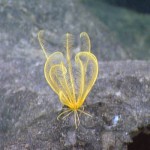Every time some bizarre animal washes ashore or is swimming around a bay, or a lagoon, there is a media hype about how it’s from the deep sea, it’s a voracious predator, and it doesn’t belong here.
A monster from the deep! Get the women and children and run for the hills. Grab your pick axes and kill it’s different and it doesn’t belong here.
Okay, maybe I exaggerated the last part. However, every morning I check the news and inevitably find an article such as…
Deep Sea Fish Washes Up on Oregon Coast – Alive
Or
Rare shark of the deep snapped
So my first step after reading these is to do all of 5 minutes of research. But before I go on let’s recap a former post, and present a basic concept.
The deep sea represents those marine environments that occur beyond the continental shelf. The average depth at which this occurs is approximately 200m (656ft), so typically we define the as those environments greater than 200 meters and extending to approximately 10,000 m (the depth of Mariana’s Trench, the deepest point in the ocean). Although the defining feature is not depth per se but rather the transition from the continental shelf to the continental slope, referred to as the shelf break. The term deep sea can be used to characterize both deep pelagic habitats, the water column greater than 200m, and deep benthic habitats, the seafloor greater than 200m.
You should care because the deep sea is the largest environment on earth.
So in the case of the longnose skate that washed ashore, ALIVE…its depth range is 25(82ft)-675m. 82ft?! This is well within the range (120ft) of recreational scuba diving. So it is not beyond the realm of reason that a human being might actually see one of these in the wild.
“But it was alive,” you say, “What about the pressure!” Pressure doesn’t kill deep-sea organisms crack temperature does. Several studies indicate the deep-sea organisms can withstand a wide range of pressures. We frequently capture organisms at depth and bring them to surface alive. They either live in aquarium in the laboratory or even shipped across the country alive. Some pelagic organisms also have amazing vertical migrations during the course of 24 hours that can encompass 1000’s of meters. Warm temperature on the other hand is bad. On trips to the Equatorial Pacific, organisms are rarely brought back to the surface alive. We ensure we keep deep-sea organisms in aquaria at 4 degrees Celsius. So it is not completely unusual that a species that gets quite shallow (82ft) would be found on a beach alive in cool waters off the coast of Oregon.
I bet the same happens elsewhere, like Japan! The frilled shark has a range of 0-1570 with typical range being 120-1280m. Again not that unexpected to find it lurking around your favorite Japanese swim hole.
So a bad operational definition of the deep sea (no 50ft is not deep) and poor understanding of marine animals is news. But maybe I hope for too much.






We commonly keep organisms alive from hydrothermal vents (from between 1700-2700m) alive in the refrigerator for the duration of a cruise (2-5 weeks) at atmospheric pressure onboard a ship.
In fact we had chemoautotrophic snails crawling around in tupperware for several days in filtered seawater… that is before i brutally assaulted them with channel locks and scalpel.